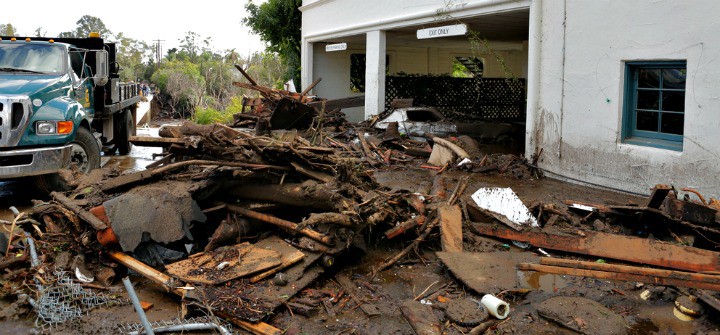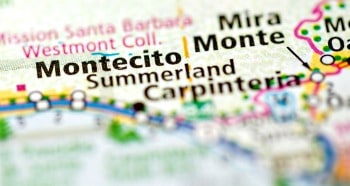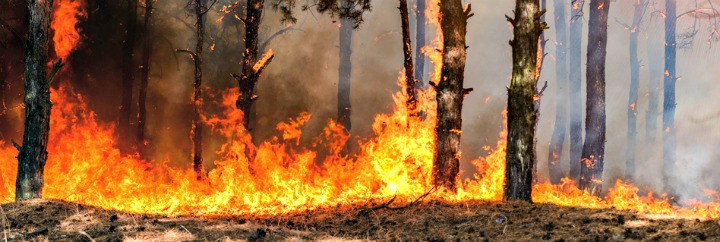Mudslide or Mudflow? Your Homeowners Insurance May Not Cover Both Disasters

Homeowners insurance coverage often comes down to nuanced differences in definitions, and the first thing a policyholder needs to understand is how insurance companies and geological scientists distinguish between mudslides and mudflows.
According to the Federal Emergency Management Agency (FEMA), “a mudflow is a river of liquid mud similar in consistency to a milkshake. Mudslides, on the other hand, are more solid and more closely resemble a cake.”
It’s critical to understand this distinction, says Etti Baranoff, insurance expert and associate professor in the Virginia Commonwealth School of Business. Mudflow damage is going to be a matter for the National Flood Insurance Program (NFIP), but mudslide damage is an entirely different animal.
“If you have damage from mud, your insurance company is first going to try and determine if this was mud or flood, and that’s going to play a big role in how things move forward with your claim,” Baranoff says.
CHECK OUT: 7 Little-Known Facts About Homeowners Insurance
According to the nonprofit Insurance Information Institute, mudflow damage is excluded from the typical homeowners’ policy but is covered by the NFIP, which is an additional insurance policy administered by FEMA and underwritten by the federal government. In other words, if you have flood insurance and your home gets damaged or destroyed by mudflow, you’re probably going to be covered.
“Your standard policy is not going to cover flood, so if you think your home might be exposed to mudflow you’ll want to purchase that additional NFIP coverage,” Walker says.
That’s been a tough lesson to learn recently for many Southern California homeowners. From early December through mid-January, wildfires burned more than 281,000 acres in Santa Barbara and Ventura counties, making it the largest fire in California’s recorded history. Then — just days after the fire had finally been contained — the mud started flowing.
 In the early morning hours of January 9, a massive and devastating mudslide walloped the Santa Barbara County town of Montecito, killing at least 20 people, destroying close to 70 homes, and damaging hundreds more.
In the early morning hours of January 9, a massive and devastating mudslide walloped the Santa Barbara County town of Montecito, killing at least 20 people, destroying close to 70 homes, and damaging hundreds more.
Officials say heavy rains saturated nearby foothills, which had been denuded by the wildfire and were, as a result, barren of vegetation that could have otherwise slowed (or stopped) the cement-thick mud from cascading toward the cozy seaside town.
“It was pretty rare, in essence a worse-case scenario from that standpoint,” says landslide expert Jonathan Godt in a recent New York Times article. “The same rainfall that falls on a burned landscape can cause a lot more damage than it would before a fire.”
The mudslide left hundreds of millions of dollars in property losses in its wake. And this has raised a suddenly critical question in the minds of many homeowners: Does my insurance policy cover damage from mudslides?
“There’s no easy answer to that question and it’s really going to depend on a few different factors,” says Evan Walker, a California-based attorney who used to work as a defense lawyer for insurance companies and now specializes in property damage law at his solo practice. “Your typical homeowners policy isn’t going to cover it, but there’s more nuance to it than that, and it’s really going to depend on the specifics of your policy and the mudslide itself.”
The recent disaster in California isn’t being classified as a mudflow event but instead as a mudslide. And this, says Baranoff, is going to cause a lot of headaches and consternation when it comes to insurance coverage.
“Don’t confuse mudflows with mudslides as there are distinct differences,” reads the Insurance Information Institute’s guidelines for this type of event. “Mudslides occur when a mass of earth or rock moves downhill, propelled by gravity. They typically don’t contain enough liquid to seep into your home, and they aren’t eligible for flood insurance coverage. In fact, mudslides are not covered by any policy.”
Nonetheless, there are possible options for homes damaged by events like the one that devastated Montecito last month.

Maybe fire is to blame for the damage?
When it comes to fire damage, Baranoff says homeowners’ policies are unambiguous.
“You’re never going to see fire damage excluded in a homeowner policy,” says Baranoff. “In fact, it’s the only thing insurers are specifically prohibited from excluding. It’s a fundamental aspect of all property insurance overage.”
Why, one might ask, would this be important? Well, because it’s widely understood that the Montecito mudslides were so extreme due to the fact that the recent wildfire burned down trees and vegetation that would have otherwise slowed the mud’s progress — and that could be a key factor in homeowners seeking compensation from their insurance companies.
RELATED: How Bad Credit Can Triple Your Homeowners Premium
“If your house caught fire because of an earthquake, you would be compensated through your homeowners’ policy even if you didn’t have earthquake coverage,” Baranoff says. “In the case of these mudslides the logic may work in reverse. If the fires are to blame for the mudslide, you might have a case to make.”
This theory has gained some traction. Consider, for instance, the following passage from a recent Los Angeles Times column by David Lazarus.
“[T]he typical home insurance plan does cover fire-related damage. So the case many Montecito residents will be making … is that the mudslides wouldn’t have happened, or been so severe, if not for the catastrophic fire.”
What’s more, Santa Barbara Democratic Sen. Hannah-Beth Jackson introduced legislation in Sacramento requiring insurers to consider the mudslides a “consequence of the wildfires,” which would mean damage is covered by homeowners insurance.
Whether this tactic will work remains to be seen.
“This is probably going to end up with a lot of litigation and examinations of case law,” Baranoff says.

You can add an ‘earth movement’ rider
It’s always possible to buy additional insurance coverage for circumstances and events not commonly included in most homeowners policies. These are called riders (or endorsements) and can add coverage for possessions like valuable antiques and artwork, or rare occurrences like volcanoes and earthquakes.
Walker says some insurance companies may allow you to purchase a rider for what the insurance industry calls “earth movements,” which might include coverage for a mudslide.
“It depends on how the insurance policy defines the rider,” Walker says. “Above all, insurance policies are contracts. Therefore, the most important thing to consider is the contractual language and how that language is defined.”
The cost of such a rider is going to vary based on numerous factors, including the value of the home, the home’s location, and the historical frequency of earth movements in the area. And while there’s no way to provide a ballpark cost for such a rider, homeowners living in a place like Montecito can be sure it won’t be cheap.
“The bottom line is that every homeowner needs to know what type of coverage he needs and what type of coverage he does or doesn’t have,” Walker says. “If you live in an area where you’re worried about mudslides, it’s up to you to figure it out.
Read the specific exclusions in your policy and talk to an insurance agent about what you might be able to add to protect you before a catastrophic event happens. If you wait until after the damage is done you might be too late.
